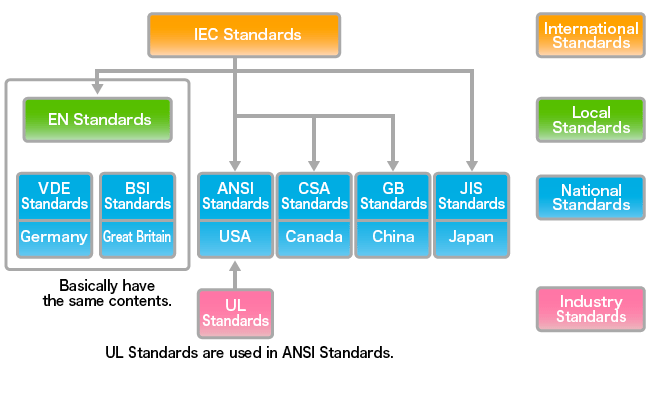LCSC supplier XFCN shares with us the standards for electronic connectors this week. In the following article, XFCN will explain in detail the safety standards for various electronic connectors.
There are two categories of electronic connector standards: those that specify the configuration of electronic connectors, and others such as communication standards that utilize standard connectors.
The standards that define the connector itself encompass those that represent the connector configuration, those that define the connector specifications based on communication standards, and so on.
Specification Example Defining Electronic Connectors
DIN 41612 Standard
The DIN standard is a German industrial association standard. Among the numerous standards, several numbers specify electronic connectors, the most famous is the DIN 41612 standard (board-to-board connector generally referred to as a DIN connector). Some standards specify round connectors.
MIL-C-83503 Standard
The MIL standard is an American standard. Like the DIN standard, this standard has various standard numbers, among which the MIL-C-83503 standard related to electronic connectors (generally known as the flat cable connector of the MIL connector) is the most famous.
IEC 61076-4-101 Standard
IEC standards are global standards.
This IEC 61076-4-101 standard is the standard for 2mm pitch HM connectors.
USB Standard
This standard is a communication standard called Universal Serial Bus, but the electronic connector itself is specified within the standard.
Other Examples of Communication Standards Using Standard Connectors
VME Bus Standard
The VME Bus (Versa Module Eurocard) standard is a communication standard for rack systems that uses the DIN 41612 connector.
Compact PCI Standard
The Compact PCI standard is an industrial computer standard specification. based on 3U or 6U Eurocard.
It uses IEC 61076-4-101 standard HM electronic connectors.
The Compact PCI standard specifies independent signal configuration, which does not match the terminal numbers of IEC 61076-4-101.
RS-232C Standard
RS-232C (Recommended Standard 232 version C) is a standardized standard from EIA, and its official name is TIA/EIA-232-E.
This specification widely connects peripheral devices such as modems and printers to COM ports, and the 25-pole and 9-pole D-sub connectors often serve for the terminals.
Safety Standards
Safety standards are set for the devices or their components to protect consumers who use electrical devices from the risks of electric shock or fire. They represent the minimum standards for preventing accidents. Each country, having different voltage conditions, weather conditions, and safety concepts, formulates and applies its standards.
After an electronic connector obtains safety standard certification, it is exempt from testing when applying for standard certification for devices that use the electronic connectors.
Safety Standards by Country
 Basic Safety Standard Requirements by Region
Basic Safety Standard Requirements by Region
North America:
The focus is on the prevention of fires caused by electrical devices. Regulations are set for the ignitability, combustibility, and temperature rise of insulation materials used in devices and components.
The main standards are UL (USA) and CSA (Canada).
Europe:
The focus is on the prevention of electric shock accidents in electrical equipment. The insulation distance and proof tracking of devices and components are specified.
The main standards are EN/IEC (Europe/International).
*Proof Tracking
The proof tracking index is the degree to which an insulator between electrodes with a potential difference loses its insulating properties due to the formation of a carbonized conductive path on the surface.
| Voltage | Accidents | Key Requirement | |
| North America | 120/240Vac | Fire | Combustibility |
| Europe | 230/400Vac | Electronic Shock | Insulation Distance |
Main Safety Standards
| Name | IEC | UL | CSA | VDE | CCC |
|---|---|---|---|---|---|
| National Standards | - | ANSI Standards | CSA Standards | EN/IEC Standards | Chinese National Standards: GB Standards |
| Country | International | United States | Canada | Europe / International | China |
| Description | Technical electric standards based on the most recent scientific technology. Forms the basis for standards in other countries. |
To prevent fires, standards are enforced for the sale of electric products in the USA by state and city. Components must also be certified. |
North American safety standards are applied and operated to prevent fire accidents, in the same way as in the USA. | Standards are designed to prevent electric shock and fires, but are not legally enforced. Enforcement is achieved through strict penalties. |
Items for which certification is enforced are specified, and the import and sale of uncertified items in China is prohibited. |
| Certification Body | UL、RU | CSA | VDE TUV-Rh |
CCC、CQC | |
| Certification Mark |  |
  |
 |
  |
  |
Founded in 2003, XFCN has been striving for the design, development, production and sales of various electronic connectors and wiring harnesses. After years of hard work, innovation and development, many of their products have obtained UL, CSA, TUV and patents for invention. View and select XFCN’s electronic connectors at LCSC.
Source: XFCN
